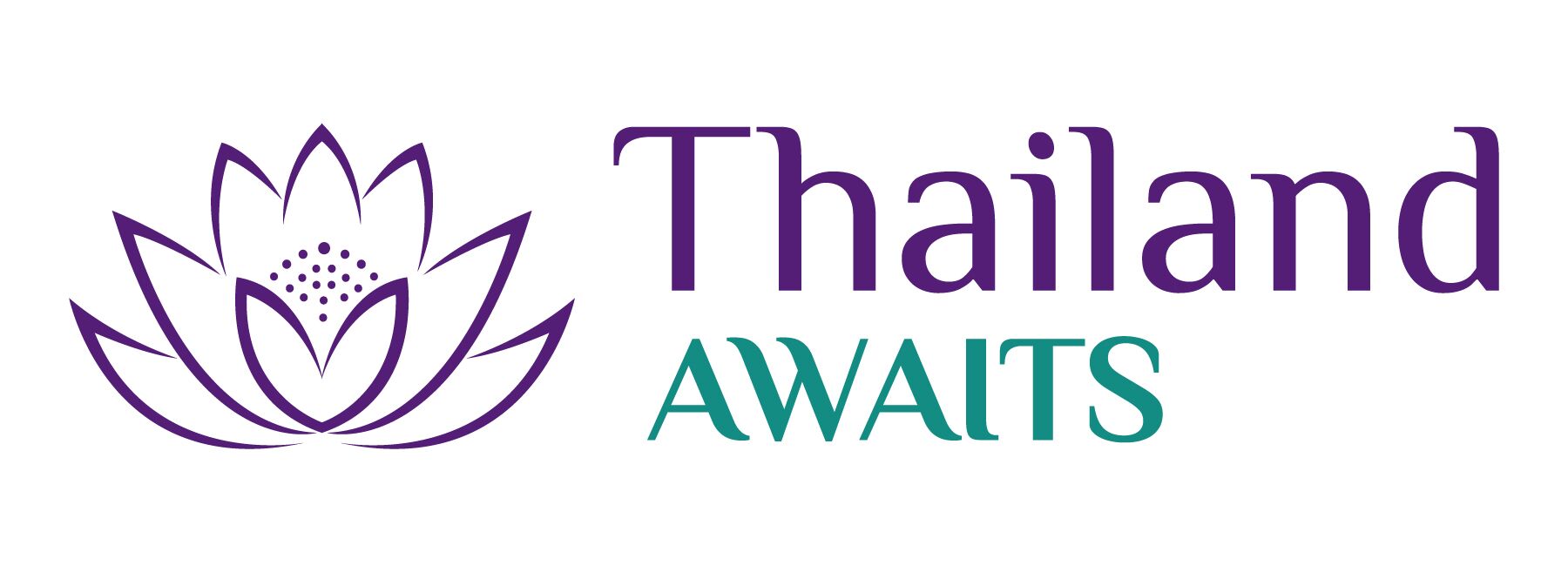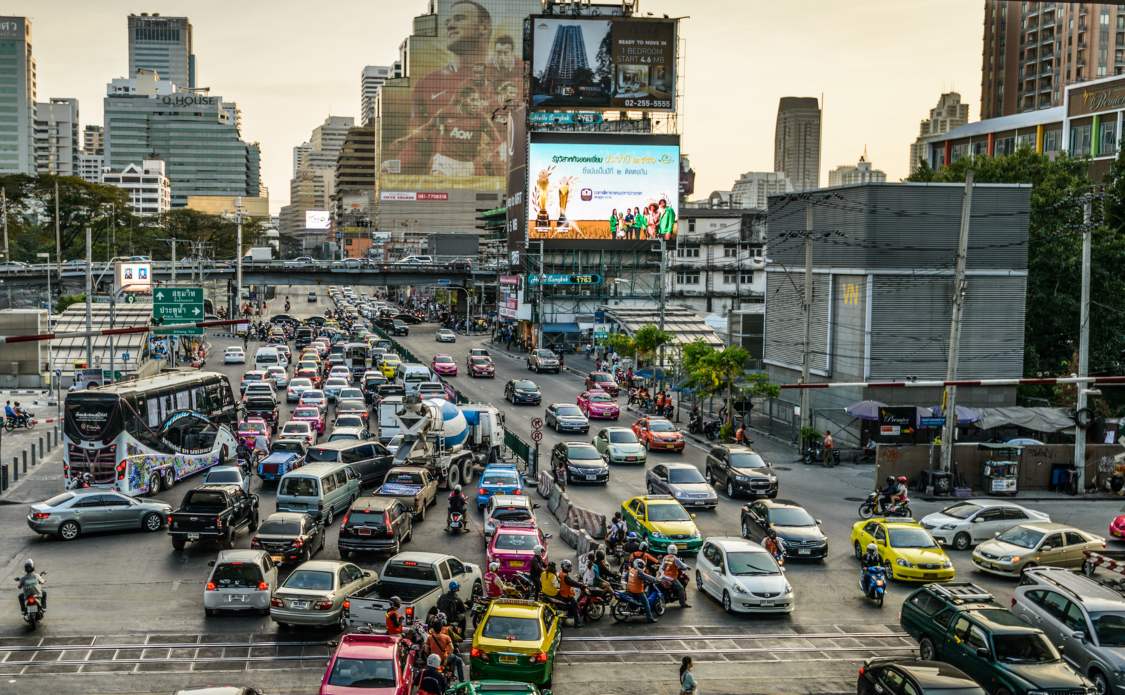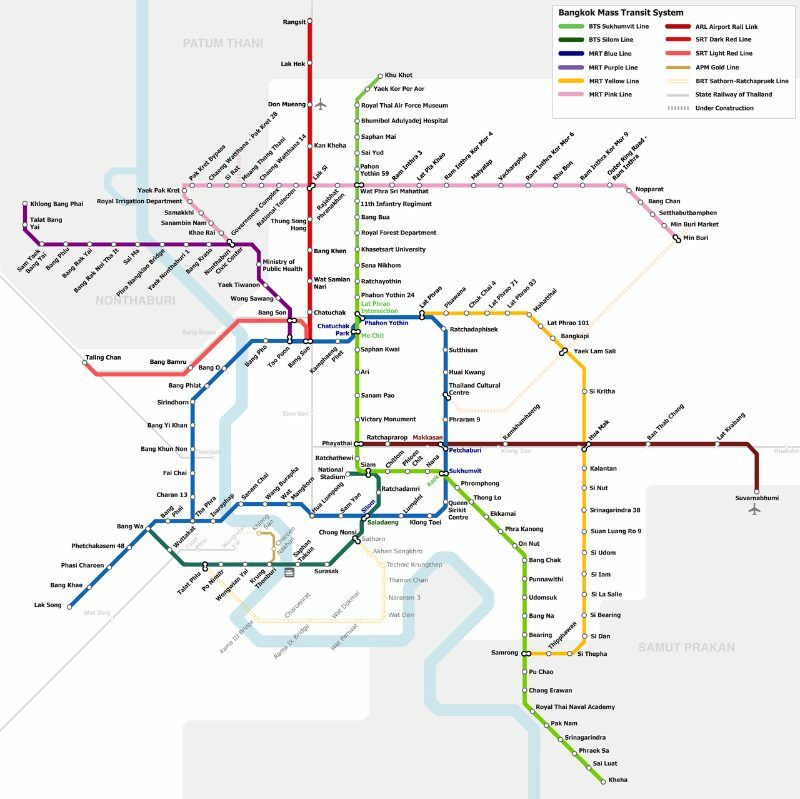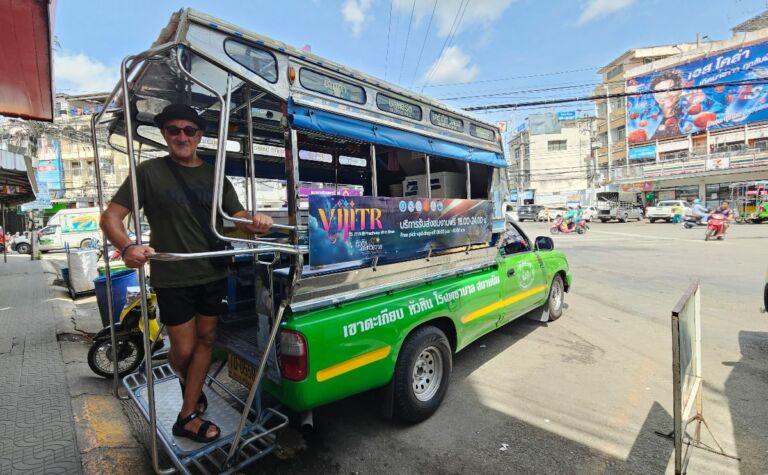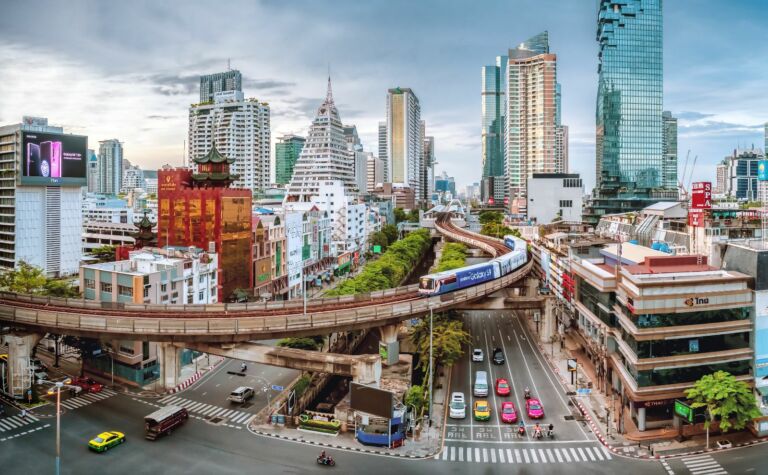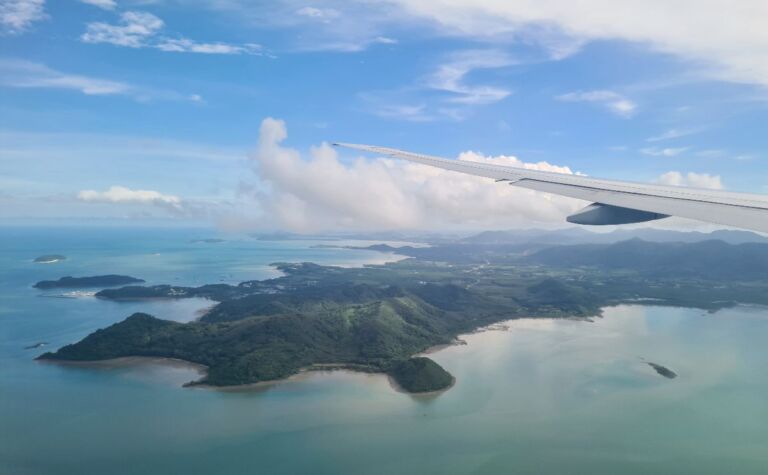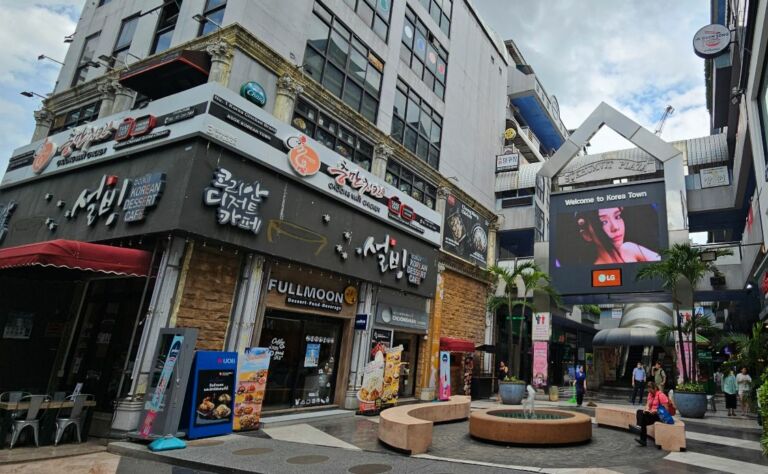The Ultimate Bangkok Transport Guide: Local Hacks and Smart Routes Revealed [2025]
“Skip the taxi – take the orange flag boat to the BTS, then grab the canal boat!” My friend’s seemingly cryptic advice made no sense at first. But that tip introduced me to Bangkok’s hidden transport network – a web of interconnected systems that locals use to zip across the city while tourists sit in traffic. After years of trial and error, I’ve mapped out these strategic combinations that transform Bangkok from a gridlocked maze into a surprisingly navigable city.
This isn’t your standard Bangkok transport guide listing train fares and bus routes (though you’ll find those basics too). Instead, I’ll show you how to think like a local: When to combine river boats with trains to beat rush hour traffic, which station exits let you avoid the crowds, and why sometimes a 20-minute wait can save you an hour of travel time.
In this guide, you’ll learn:
- Strategic combinations that save time
- Which routes locals use to beat Bangkok’s notorious traffic
- When to splurge on taxis (and when cheaper options are actually faster)
- Money-saving hacks that many visitors never discover
- Station-by-station guides for popular destinations
➡️ Just landed? Here’s our detailed Bangkok Airports Transport Guide
By the end of this guide, you’ll understanding of Bangkok’s transportation options, allowing you to explore the city efficiently and on a budget.
This page contains affiliate links. Please see our disclosure policy for more details.
Getting Around Bangkok: The Basics
I remember my first visit to Bangkok – I stuck to taxis and ended up spending half my time stuck in traffic. Each trip since then, I’ve discovered new ways to get around. The BTS Skytrain came first (easy!), then the MRT subway, and finally the river boats and buses. Now I mix and match them all depending on where I’m heading.
Trains (BTS & MRT)
Trains are the backbone of Bangkok transport, combining elevated Skytrain (BTS) and underground (MRT) systems. They are the best way to reach most tourist areas.
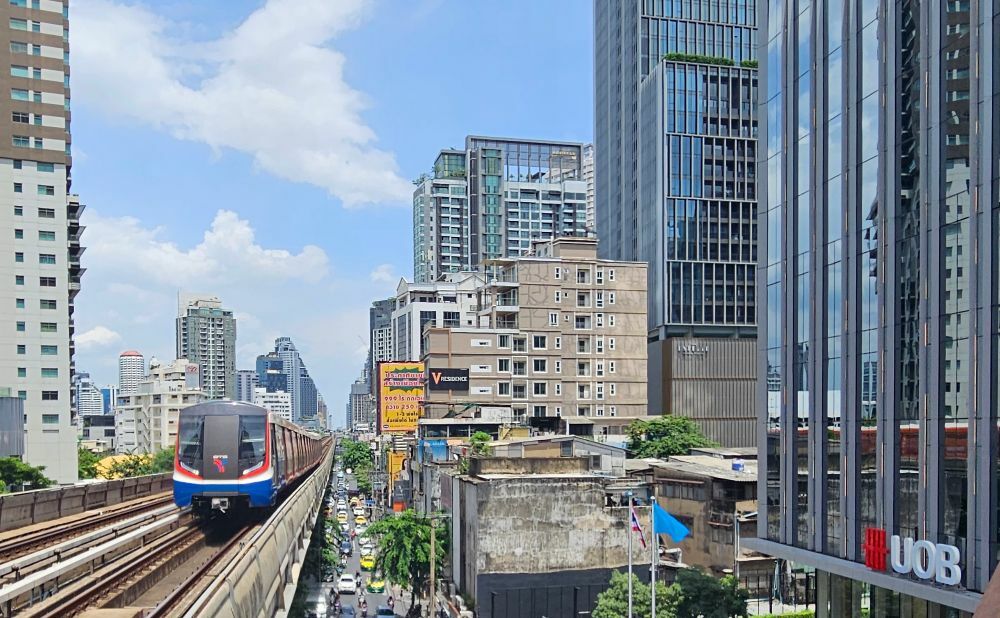
- Perfect for: Sukhumvit Road and Central Bangkok shopping areas
- Cost: 16-70฿ per trip – day passes 150฿
- Pro tip: Get a Rabbit Card if staying 3+ days, it will save you time.
River & Canal Boats
Getting on the water is Bangkok’s secret weapon against traffic. Both the Chao Phraya express boats and the canal boats plying the Saen Saep canal offer scenic routes to major attractions. I recommend every visitor take at least one ride on the river.
- Perfect for: Old Town, temples, riverside attractions
- Cost: 15-40฿ per trip
- Pro tip: Orange Flag boats are your best friend for most tourist routes
Taxis & Ride Apps
Essential for late nights and rainy days, with two distinct options:
- Traditional Taxis: Best for short trips, meter starts at 35฿
- Ride Apps (Grab/Bolt): Best for language barrier, upfront pricing
- Pro tip: After 10pm, combine train to outer stations + short taxi ride to beat surge pricing
Local Buses
The local’s choice for budget travel, intimidating at first but rewarding to master. If you are staying in Khao San Road I recommend you use the cross city buses to get to Siam. It will save you a lot of money.
- Perfect for: Off-the-tourist-track areas, budget travel
- Cost: 8-24฿ (regular vs air-con)
- Pro tip: Start with the Smile electric buses – they have clear route numbers and English signs
Smart Combinations: The Local’s Bangkok Transport GUiDE
Before diving into individual transport options, here’s the most important lesson I’ve learned: Bangkok’s transport systems work best when combined strategically. Here are my go-to combinations that will immediately upgrade your Bangkok experience:
Temple Circuit (Save 1+ hour, 200฿)
For visiting Bangkok’s famous temples, I always take the MRT to Sanam Chai station. This beautiful station drops you just a short walk from the Grand Palace and Wat Pho (the reclining Buddha temple).
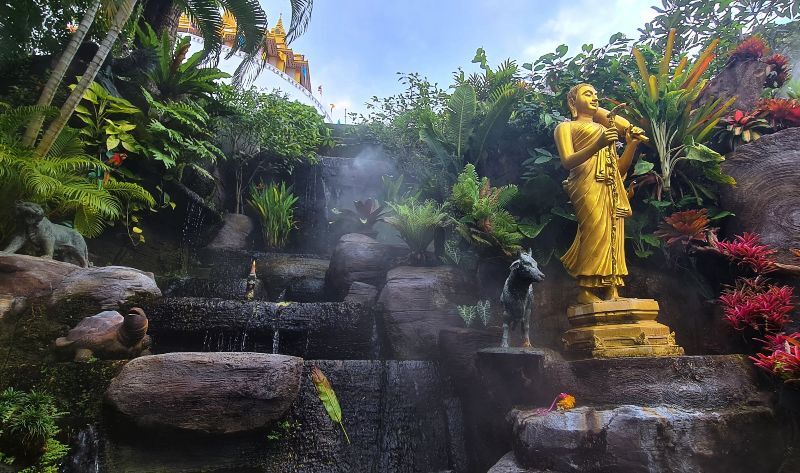
From Wat Pho’s pier, it’s just a quick hop across the river on a tiny ferry to reach Wat Arun. The whole journey costs about 100฿ and saves at least an hour compared to taking taxis through traffic.
Pro tip: Start early! I aim to reach Sanam Chai station around 8am to beat both the heat and crowds. Plus, the station itself is gorgeous – it feels more like a palace than a metro stop!
The Shopping Mall Hack (Stay cool, avoid crowds)
Shopping in Bangkok is so much easier once you realize how the BTS connects to major malls. I usually start at Siam station, using the elevated walkways to hop between malls like Siam Paragon, Central World, and MBK. When my arms are full of shopping bags, that’s when I switch to Grab for the journey home.
Most shopping centres have a Grab pick up zone so find your way here for an easier journey home.
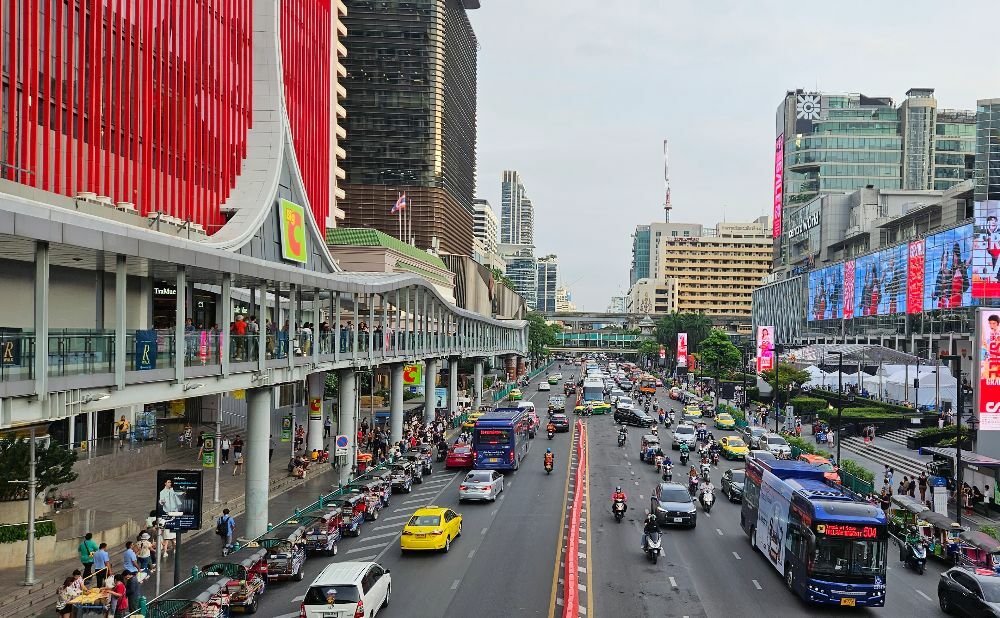
Pro tip: Look for signs pointing to “Skywalk” – these covered walkways keep you cool and dry between malls.
Chatuchak Market Strategy (Beat the Crowds)
The world’s largest weekend market can be overwhelming, but here’s my tried-and-tested approach to making it manageable.
I start by taking the BTS to Mo Chit station – it’s an easy walk to the market entrance from here. After a few hours of shopping (and when my arms are full of purchases), I usually head home via the MRT from Chatuchak station instead.
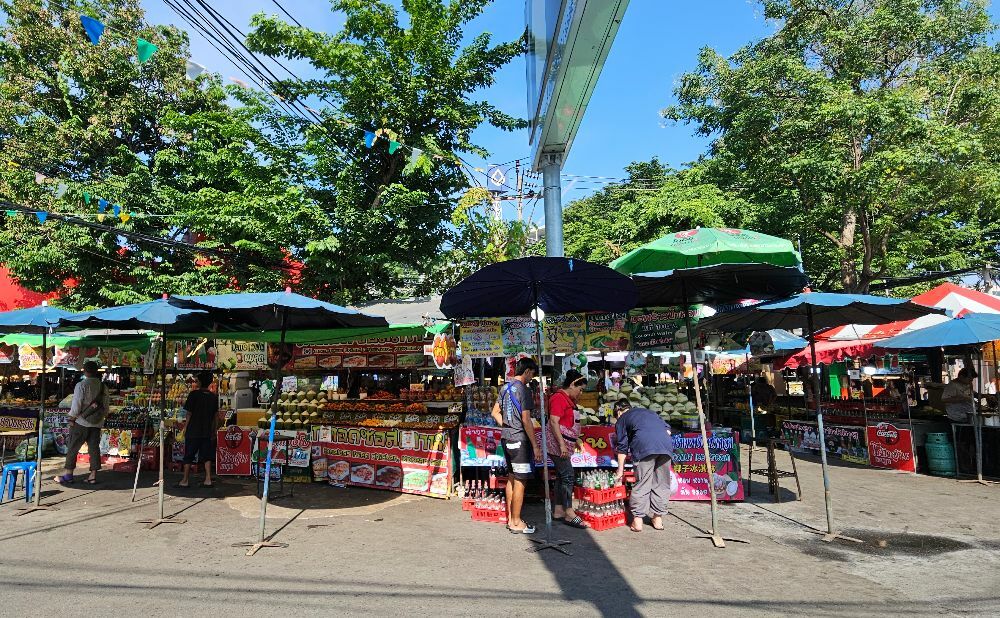
Using different stations for arrival and departure helps avoid the worst crowds – trust me, the BTS gets packed with market-goers by mid-morning! The whole journey costs about 100฿ round trip.
Pro tip: There’s a luggage storage service near the market entrance if you end up buying more than you can carry.
Chinatown Food Crawl (Easy In, Smart Exit)
Want to dive into Bangkok’s best street food without getting stuck in notorious Chinatown traffic? This MRT-to-Grab combo lets you feast worry-free.
For exploring Chinatown’s famous street food scene, I always take the MRT to Wat Mangkon station. The station drops you right in the heart of the action.
After wandering the bustling food streets and probably eating too much, I usually grab a ride home – walking back to the MRT on a full stomach isn’t much fun!
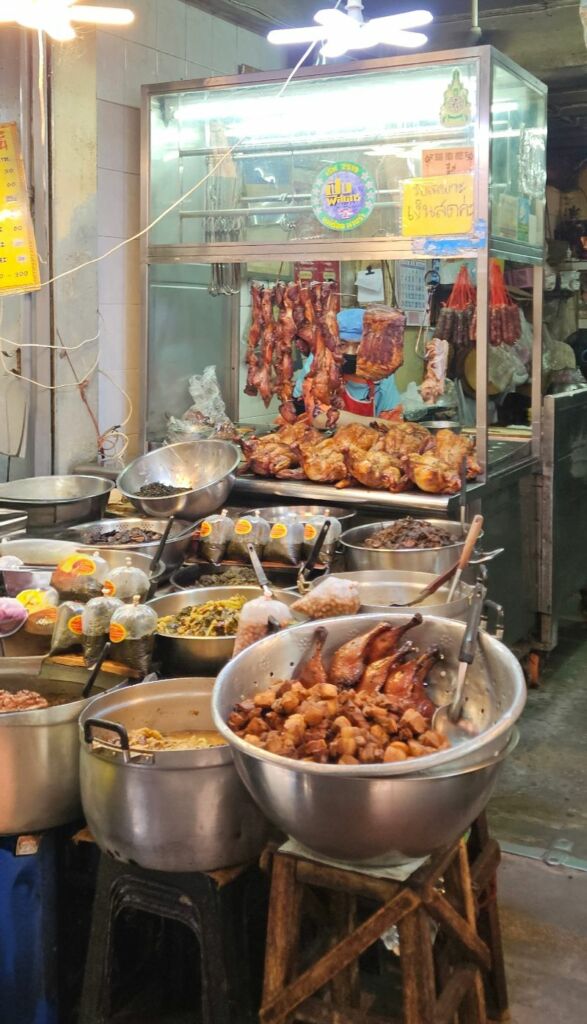
This MRT-to-Grab combo typically saves 200฿ compared to a round-trip taxi fare, and you’ll avoid sitting in Chinatown’s notorious evening traffic jams. If you want to experience a Tuk Tuk ride this can be a good place to do that.
Pro tip: Even with the combined MRT and Grab costs (about 150฿ total), this works out cheaper than a round-trip taxi that would likely get stuck in traffic.
The Late Night Strategy (Save 50%+ on surge pricing)
Getting back to your hotel late at night doesn’t have to cost a fortune. When I see Grab’s surge pricing hitting hard (which often happens on wet evenings), I have a strategy: I take the BTS or MRT as close as I can to my destination, then take a regular taxi for the final stretch.
This combination usually costs about half what you’d pay for a direct Grab during surge pricing. Plus, taxi drivers are often more willing to take these shorter trips than go across the city.
Pro tip: If surge pricing is really high, sometimes it’s worth waiting 15-20 minutes – prices often drop once the rush dies down.
Coming from the Airport?
Bangkok has two airports, and getting into the city can be tricky. Check our detailed Bangkok Airport Transport Guide for step-by-step instructions and money-saving tips for reaching your hotel from either airport.
Key tips:
- Airport Rail Link connects from both airports to BTS/MRT systems
- Taxi prices should be 350-450฿ to central areas
- Express buses available to some areas
Transport Deep Dive: Everything You Need to Know
Now that you’ve seen how locals combine different transport options, let’s explore each system in detail. Whether you’re planning your first temple run or preparing for late-night adventures, understanding these systems will help you navigate Bangkok like a pro.
Remember: No single mode of transport is perfect for every situation. The key is knowing the strengths and limitations of each option, then mixing and matching based on your needs.
Bangkok Trains (BTS & MRT)
The BTS Skytrain (elevated) and MRT (underground) are Bangkok’s most reliable transport options.
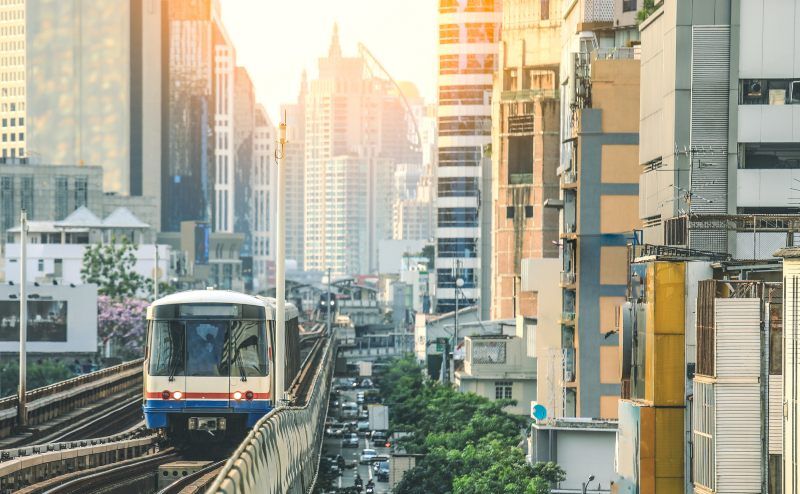
The BTS has two lines covering central Bangkok and Sukhumvit, while the MRT runs in a semi-loop through the city.
They’re perfect for:
- Shopping areas and business districts
- Quick trips across the city
- Avoiding traffic completely
My one tip for using the BTS/MRT is to avoid rush hours, particularly at the busiest stations, which are Siam, Asok and Mo Chit. If you don’t have to be travelling at 9-10am or 5-6pm, don’t!
Key things to know:
- Two BTS lines + MRT lines cover most tourist areas
- Stations well-marked in English
- Operating hours: 6am to midnight
- Avoid rush hours (8-9:30am and 4-7pm)
Cost: 16-70฿ per trip
Operating hours: 6am to midnight
My take: This is my go-to transport. Air-conditioned, fast, and stations are well-marked in English.
River & Canal Transport
Bangkok’s waterways offer some of the most scenic – and often fastest – ways to get around. After years of sticking to land transport, discovering the river boats completely changed how I explore the city.
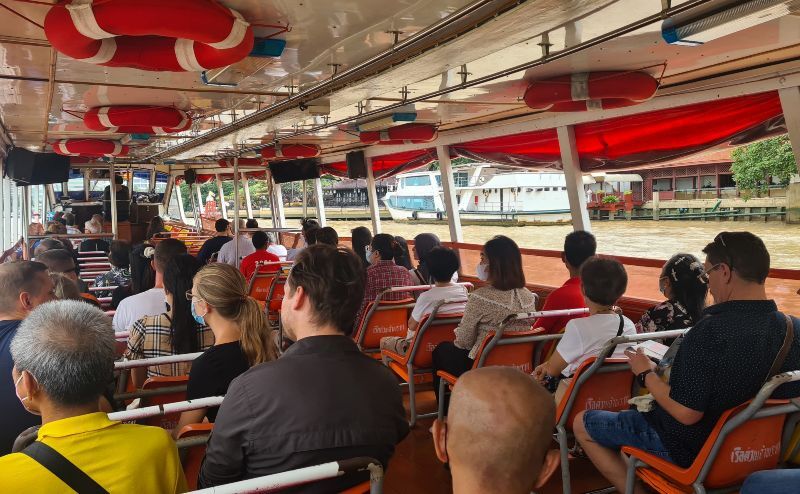
Main boat services:
- Chao Phraya Express Boats (orange flag is most useful)
- Cross-river ferries (just 4฿!)
- Canal boats (local commuter services) especially useful for travelling from Sukhumvit to the old town
- Tourist boat (blue flag – more expensive but English commentary)
- Chao Phraya Express Boats (orange flag is most useful)
- Cross-river ferries (just 4฿!)
- Canal boats (local commuter services) especially useful for travelling from Sukhumvit to the old town
- Tourist boat (blue flag – more expensive but English commentary)
Best for:
- Temple visits (Grand Palace, Wat Arun, Wat Pho)
- Avoiding traffic jams
- Reaching Chinatown
- Getting to riverside malls like ICONSIAM
My river transport tips:
- Orange flag boats are cheapest (16฿ flat rate)
- Main pier connects to BTS at Saphan Taksin
- Boats stop running earlier than trains (usually last boat around 7-8pm)
- Hold on tight – they can be bouncy!
Get detailed route maps and pier guides in our River & Canal Transport Guide
Local Buses
Bangkok’s extensive bus network is something most tourists overlook, but it’s worth understanding the basics. While I was intimidated at first, buses turned out to be a great way to reach places the trains don’t cover.
Types of buses you’ll see:
- Air-conditioned (orange or yellow): 11-24฿
- Regular “fan” buses (various colors): 8฿
- Express services on main routes
My tips for first-time bus riders:
- Have exact change ready
- Show your destination in Thai to the conductor
- Use Google Maps to track your journey
Best for:
- Budget travel
- Reaching outer areas
- Local experience
- Avoiding traffic (some buses use dedicated lanes)
Get detailed routes and bus numbers in our Bangkok Bus Guide
Metered Taxis
Bangkok’s colorful taxis are everywhere – you’ll spot hot pink, yellow-green, and blue ones cruising the streets. Most of my taxi experiences have been good, especially since I learned a few tricks.
One memorable evening, I hopped into a bright pink taxi after a late dinner, and the driver, sporting a friendly smile, chatted with me about his favorite local restaurants while weaving through the traffic.
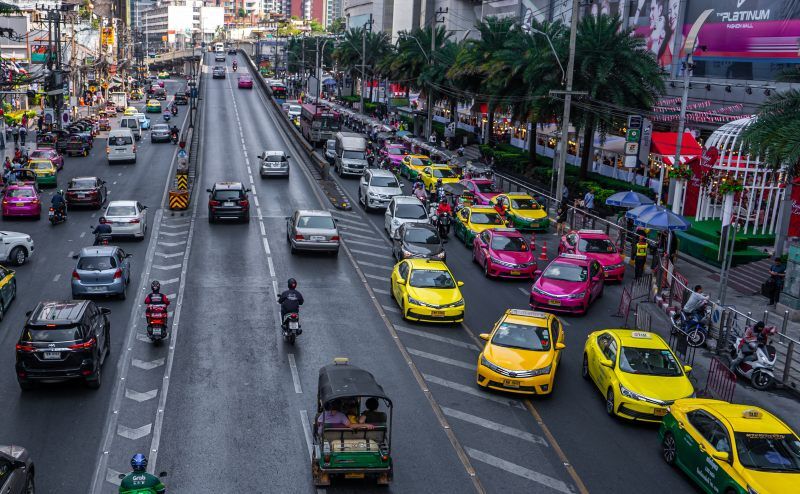
Sure, I hit a few snags here and there, like that one time a driver insisted on a fixed fare, but a little assertiveness can go a long way.
The meter always starts at 35฿, and a typical 20-minute journey costs around 100- 150฿. That said, traffic can seriously impact your fare. I once ended up paying triple for the same journey just because I traveled during rush hour.
Getting a metered taxi is usually straightforward in most areas, but there are exceptions. Around tourist hotspots like the Grand Palace or Khao San Road, drivers often try to negotiate fixed fares instead of using the meter. Just walk a bit further from these areas to find drivers willing to use the meter.
If you are planning to visit Maeklong Railway Market it can be better to take a tour instead of a taxi.
Ride-Hailing Services
After one too many late-night adventures trying to explain where I want to go in broken Thai, I began to use the local ride-hailing apps. There are two main services, Grab and Bolt.
These days, I have both on my phone and switch between them depending on which has drivers nearby.
What I love about these apps:
- No haggling about meters
- Price shown upfront
- Can pay by card instead of cash
- Many drivers speak English
- Track your journey in real-time
The two services are pretty similar in price and service. During rain or peak hours, prices can surge, but I usually just wait 15-20 minutes for them to drop back to normal. The drivers often share great local tips too – I found some of my favorite restaurants through chat with Grab drivers!
Essential Apps and Passes
Now that you know all the different ways to get around Bangkok, let me share look at the apps and passes that make navigating the city so much smoother.
After countless trips, I’ve narrowed down the essentials to just a few key items:
Must-Have Transport Apps
- Grab and Bolt– These are essential for getting around, especially at night. Having both installed gives you more options and better prices.
- Google Maps – Download the Bangkok map before you arrive – it works offline and shows most transport options.
- BTS/MRT apps – Nice to have, but honestly, Google Maps works fine for most journeys.
Bangkok Transport Cards
If you are in the city for a longer stay then a Rabbit card is a worthwhile purchase. I have not purchased an MRT card and use my credit card to pay for MRT rides but if I was commuting daily via MRT I would get the card.
Rabbit Card
- Perfect if staying 3+ days
- Costs 100฿ (50฿ card + 50฿ minimum top-up)
- Available at any BTS station
- Saves time buying individual tickets
MRT Card
- Best for daily users on longer stays
- Costs 180฿ (100฿ card + 80฿ minimum top-up)
- Available at any MRT station
- Worth it if using MRT daily
HOP Bangkok Card
- Perfect for: Smile buses and river ferries
- Cost: 100฿ (refundable 50฿ deposit + top-up)
- Where to get it: Major transport hubs or 7-Eleven
- Worth it if: Planning to use public buses or frequent river crossings
Transport Tips by Situation: Dealing with Bangkok’s Challenges
Even with all the right apps and passes, certain situations in Bangkok need special strategies. Here are solutions I’ve discovered for common challenges:
Rush Hour Strategies
Morning (7-9am) and evening (4-7pm) rush hours in Bangkok can be intense. Here’s how I handle them:
On the BTS/MRT
- Avoid changing trains at Siam or Asok if possible
- Let a crowded train pass – the next one is usually quieter
- Stand near the doors if your stop is coming up soon
Alternative Routes
- River boats often beat trains during peak times
- Walking between nearby stations can be faster
- Consider starting your day later or grabbing breakfast near your hotel
Late Night Navigation
Bangkok’s transport options change after dark. Here’s what you need to know:
Transport Cut-off Times
- BTS/MRT: Last trains around midnight
- River boats: Most stop by 7pm
- Night buses: Run on main routes until dawn
Getting Home Late
- Book Grab/Bolt before peak surge times
- Consider splitting your journey (train + taxi)
- Have your hotel address in Thai ready to show drivers
When Things Go Wrong
Even the best-laid plans can go awry in Bangkok. Here’s how I handle common problems:
Transport Issues
- Missed the last train? Don’t panic – a Grab usually costs less than multiple taxis
- BTS card not working? The staff at ticket windows are usually very helpful
- Can’t find a metered taxi? Walk a block away from tourist areas and try again
Navigation Problems
- Lost? Most BTS Stations and convenience stores have some staff who speak English
- Phone battery dying? Major malls and BTS stations have charging points
- Getting late? Consider breaking your journey into stages using BTS/MRT
Communication Tips
- Save your hotel’s address in Thai
- Screenshot your destination on Google Maps
- Keep your hotel’s business card handy
- Learn to say “meter please” (meter, ka/krap)
Bangkok’s Iconic Transport Experiences
After covering all the practical ways to get around, let’s talk about some of Bangkok’s more memorable transport options.
Riding a Tuk-Tuk
Nothing says “I’m in Bangkok” quite like a tuk-tuk ride. These three-wheeled vehicles are part of the city’s charm, even if they’re not always the most practical choice.
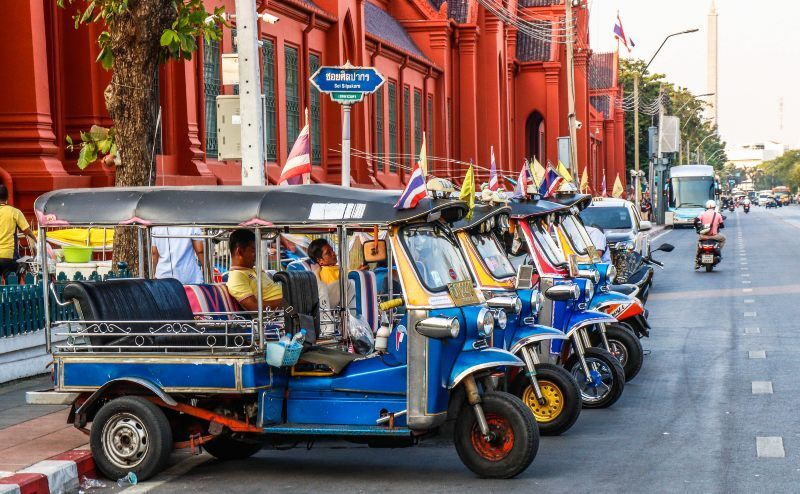
I still remember my first tuk-tuk ride – equal parts terrifying and exhilarating!
When to Use Them
- Short hops between temples
- Evening rides when it’s cooler
- Small shopping trips (you can keep an eye on your bags)
- Those iconic Bangkok photos!
What to Pay
- 100฿ for a 10-minute journey is fair
- 100฿ for a 1-2km or 200฿ for a 3-5km journey is fair
- Negotiate price before getting in
- Expect higher prices during the day in tourist areas. Rates will be higher when shops and markets are closing or when its raining.
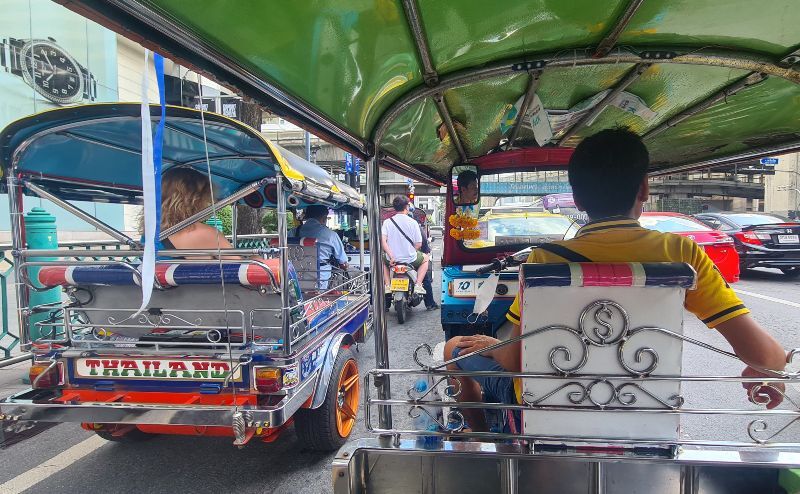
Watch Out For
- Rush hour traffic (exhaust fumes at street level)
- Midday heat (no air-con and lots of sun)
- The “temple is closed” scam (ignore this – temples are open!)
- Rainy season (you will get wet)
You can also do a street food tour by tuk tuk, which is loads of fun! They even have one that starts at midnight!
Motorcycle Taxis: The Traffic Beaters
You’ll spot motorcycle taxi drivers in their bright orange vests at the end of most side streets (sois). While many locals use them to beat Bangkok’s traffic, I have never used motorcycle taxis and probably won’t because I am not confident on the back of a bike.
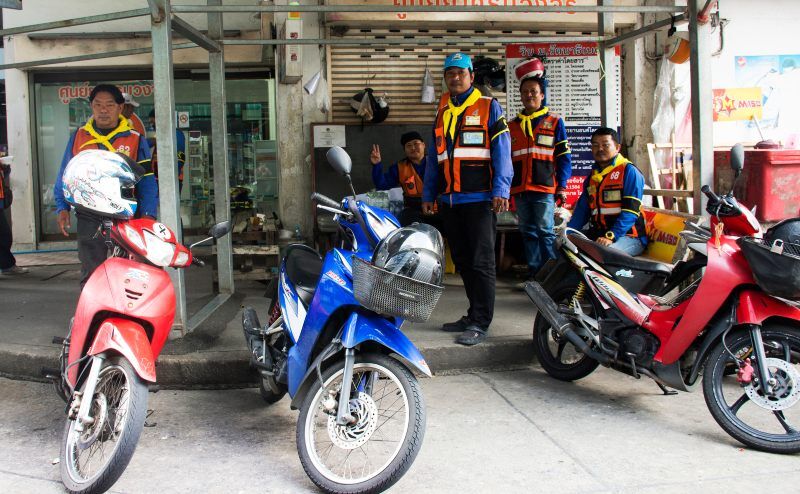
If you do want to try them, I’d only recommend this if:
- You have previous experience riding on motorcycles
- The driver has a spare helmet for you to wear
- You’re traveling light (no shopping bags or luggage)
For those who do use them:
- Some stations have designated motorcycle taxi stands
- Most regular routes have set prices (around 20฿ to nearest BTS)
- They’re popular with locals for beating traffic
- You’ll find them at the end of most side streets
But for confident solo travelers these will save you time and money. Just make sure your travel insurance covers you being on a bike.
Putting It All Together: My Best Transport Tips
After countless trips around Bangkok, here’s what I’ve learned about getting around efficiently:
My Personal Transport Rules
After several years of trial and error, these are the guidelines I follow:
- Under 3 stops on BTS/MRT: Always worth it
- Crossing the river: Boats beat taxis every time
- Rush hour journeys: Add 50% to taxi times
- Late night: Book Grab before peak surge pricing hits
- Late night: Book Grab before peak surge pricing hits and for more chance of the car turning up book an executive car. These are about 20% more but they rarely cancel your trip.
Final Thoughts
Bangkok’s transport system might seem chaotic at first, but it’s actually pretty logical once you know the tricks. Start with the BTS – it’s the easiest to master. Then gradually add boats, MRT, and finally buses as you get more confident.
Remember: no single transport type is perfect for every journey. The real secret is mixing and matching based on the time of day, your destination, and how much you want to spend.
Want more detailed guides?
- ➡️ Just landed? Here’s our detained guide to Airport Transport
- ➡️ Ready to tackle the trains? Check our BTS & MRT Guide
- ➡️ Interested in river travel? See our Bangkok by boat guide
- ➡️ Feeling adventurous? Read our local bus guide
My top tips? Grab a Rabbit card if you’re here for more than a few days, don’t be afraid to try the river boats for a different view of the city, and always keep some small change handy for those spur-of-the-moment rides.
Remember, every Bangkokian has their own transport hacks, so don’t be shy about asking locals for advice. Before you know it, you’ll be giving directions to other tourists! Happy exploring, and enjoy all the amazing sights, sounds, and tastes Bangkok has to offer.
Planning a Thai adventure? Join our friendly Facebook community Thailand Awaits: Trip Planning for Beginners. Get expert advice from locals and experienced travellers, ask your questions, and discover how to make the most of your journey through Thailand.
